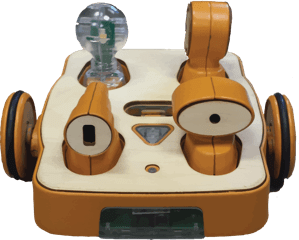
| Example #1: A child gives a peer an idea about programming KIBO to do a dance. |
| Example #2: A more experienced child helps a novice peer by showing her how to scan the blocks in her program. |
| Example #3: Two children build a program together by alternating who gets to choose the next block of the program. |
Watch Collaboration in Practice
Running Programs Together
Four children run the programs for two KIBO robots at the same time.
Working Together to Scan Blocks
One child scans a particular block while the second child covers up the other blocks.
Taking Turns Recording Sounds
Children take turns recording silly sounds for KIBO to play.
Recording the Same Sounds
Two children record the same “blah blah blah” sound for their KIBO robots to play.
Building a Program Together
Two children work together to connect the blocks of their program for KIBO.
Assembling KIBO Together
One child holds KIBO still while another child attaches a part.
Divvying Up Roles
Children divvy up roles in order to scan KIBO’s blocks together.
Holding Up a Bridge for KIBO
Two children hold a paper bridge up out of their KIBO robot’s way.
Students Collaborating on a Project
A small group of students collaborate to create a code for their KIBO robot.
Kids Working in Teams
This class split into two groups for students to collaborate on their assignment together.
Blah Blah Blah
Children work together to record sounds for KIBO.
